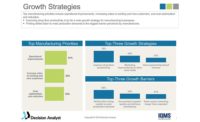Discovering the underlying factors that influence compliance, product quality, production efficiency and your performance as a supplier requires greater accuracy and precision than many manufacturing metrics provide. Too often, the reason that return material authorizations, customer rejects, product returns, and a supplier’s quality incoming levels are fluctuating are explained with anecdotal observations and incomplete data sets that lack repeatability and reproducibility.
Manufacturers can significantly improve their visibility into operations through gage repeatability and reproducibility (GR&R) studies. However, in the quest for growth, many manufacturers lack the time to excel at tool and gage measurement. These businesses are facing severe time shortages, and it’s common to see production centers running two and three shifts to accommodate the short production run their customers need. As a result, the time required to manage tooling and gages often is sacrificed to provide customers the flexibility and short-notice production support they need while keeping orders on schedule.
Instead, manufacturing centers regularly procrastinate getting their gage calibration, tracking, and GR&R studies done on a regular schedule. Those are delays few companies can afford to make because putting off GR&R studies and calibration is just as hazardous as driving a car without checking the oil for a year. Both problems aren’t going to end well, and they are going to be expensive to fix.
Gage Management and Growth Potential
The bottom line is that strong gage management and tracking, along with consistent completion of GR&R studies, will impact any manufacturer’s ability to grow. Moreover, excelling at product quality depends on the ability to reprioritize GR&R studies to create an accurate, reliable base of continuous data that fuels statistical analysis. This analysis may take many forms, including statistical process control charts, dashboards, and balanced scorecards. Designed to explain variances in production and quality data, gage management techniques—including gage calibration, GR&R studies, and gage tracking—all contribute to greater knowledge of how to solidify and strengthen every aspect of product quality and performance.
To begin, companies need to have a renewed focus on conducting regular measurement system analysis (MSA) in order to get to the root cause of why compliance, quality, production efficiency, and machinery maintenance levels are fluctuating. Manufacturers also need to rely on gage management and GR&R studies to explain variations in more aggregated quality metrics. These metrics and key performance indicators (KPIs) include yield, or the percent of products that are manufactured to customers’ requirements the first time (not rework), and defects per unit, defined as the total number of defects identified on all units divided by the number of units produced. Additionally, customer rejects, return material authorizations and returns often reflect inconsistent production processes that lack the continuous data they need to improve.
The Role of GR&R Studies
From the most aggregated to granular metrics of quality and production performance, GR&R studies are designed to provide the trustworthy foundation for repeatable, reproducible results. Repeatability and reproducibility are the cornerstones of knowing the truth about what level of product quality is achievable for a specific plant floor or a series of manufacturing centers. Repeatability defines the variation in data captured when the same engineer measures the same part, assembly or component multiple times with the same device or measurement instrument. Reproducibility captures the variation from different engineers measuring the same part multiple times with the same measurement instrument.
Gage repeatability and reproducibility studies excel at finding the reasons why quality, production efficiency, and total productivity maintenance performance levels fluctuate. When these three areas see variability and lack consistency, customers immediately recognize the result in low-quality products that are returned. Tools, gages, and machinery start to break down because they are not being used as designed. Getting quality and most importantly customer satisfaction back on track requires first defining GR&R studies that are trustworthy and solidly performing on part-to-part consistency, repeatability, and reproducibility.
The best way to get GR&R studies back into a high priority role is to link their results to revenue, so production centers can readily see their contributions to company growth.There’s also greater accountability for results when each aspect of quality is being measured as closely as it can to cost reductions and revenue contributions.
Let’s look closer at seven proven ways that gage management techniques, including GR&R studies, directly contribute to higher product quality and drive revenue based on a manufacturer’s results. The approaches are based on practices being employed by manufacturers across North America, Europe, and Asia-Pacific.

Strong gage management and tracking will impact any manufacturer’s ability to grow.
Variance Scores
One of the best indicators of operator training effectiveness, which has an immediate impact on quality, is the use of variance scores in gage management and GR&R studies. The ability to know what is causing variations in product quality down to the tool and gage level—and if there are training gaps in operators’ knowledge—is invaluable in quickly turning around potentially damaging product quality levels. Many of the best GR&R studies rely on analysis of variance (ANOVA) statistical techniques to quantify how each factor measured contributes to an explanation of product, machine and operator variation. For example, a pump manufacturer is using GR&R studies to analyze the factors causing quality to vary significantly from one pump produced to the next. Using ANOVA in conjunction with gage measurement, a specific tool was found to explain 43% of the quality variance at the .01 level of confidence. ANOVA is invaluable in pinpointing the factors causing product quality problems.
Quality Management
Companies are strengthening their quality management by turning to manufacturing execution system (MES) solutions that automate tool and gage management. Doing so also enables manufacturers to get into a more regular cadence of doing GR&R studies, scaling the results across production. By capturing tool and gage measurement data as part of a quality management system integrated with an MES application, manufacturers can more effectively track tool certifications and conduct regular audits to ensure compliance with industry and government standards.
Supplier Performance
Gage management and GR&R studies are leading indicators of your level of supplier quality and performance. That’s why making gage management a priority, and finding the time to do it, is essential to excelling at fulfilling existing orders and winning new ones. Knowing why there are variations in quality from one product to the next is imperative if quality is going to become a company-wide strength. That’s why gage management is often an integral part of the inbound inspection of all supplies, components and assemblies from suppliers. One medical device manufacturer relies on gage management audits every month to make sure all inbound supplier shipments that the quality team inspects comply with federally mandated standards. Supplier quality management is as much about making sure the tools and gages used to measure inbound shipments are as accurate and in calibration as those used on the production floor.
Track and Traceability
Providing an added level of insight and intelligence into track and traceability from supplier to finished product enables manufacturers in regulated industries to stay in compliance, averting fines. In the most highly regulated industries, such as medical products manufacturing, the added dimension of tool and gage measurement data enables manufacturers to excel at compliance. By having a gage management program in place supported by GR&R studies, manufacturers competing in highly regulated industries including medical products have an audit trail of compliance to the tool and gage level. And having tool and gage measurements up to date and in compliance with quality standards also streamlines the production process for medical devices, which must deliver every device with a device history record per the U.S. Food and Drug Administration (FDA) mandate. Among manufacturers, those in the medical products sector are the most rigorous in applying tool and gage management, alleviating costly fines, warning letters from government agencies and at the extreme, plant shutdowns as well.
DMAIC and Six Sigma
Manufacturers can improve their Define, Measure, Analyze, Improve and Control (DMAIC) data driven improvement cycles and reduce the time it takes to complete Six Sigma projects while increasing the quality of products delivered to customers. Six Sigma is a framework for discovering why variances in product and process quality exist while DMAIC is a core methodology for discovering and acting on variance data. A core aspect of the DMAIC methodology is the measurement phase, which is where tool and gage management including GR&R studies have the greatest impact today. Therefore, gage management and GR&R studies are essential for making Six Sigma projects successful as they provide the measurement data that enables the DMAIC phase of any Six Sigma proejct to succeed. In turn, improving Six Sigma performance makes a direct contribution to customers getting products that meet or exceed their quality standards.
Production Audits
Production audits that include tool and gage measurements, including GR&R studies, can uncover unexpected areas for quality and operator improvement. It’s best to consider GR&R studies as one of the most trustworthy and unbiased continuous streams of data available for sustaining and improving product quality. By adding a continuous stream of quality data into the framework of a production audit brings a level of acuity and analysis not possible with any other monitoring technique. Gage repeatability and reproducibility are the foundations of all GR&R studies and gage management techniques, and they are must-haves for knowing the true scope of product quality and its impact on customers and revenue growth.
Perfect Order Performance
Leading global tech manufacturers today are capitalizing on the lessons learned from gage management techniques including GR&R studies to increase perfect order performance. One of the world’s best-known personal computer manufacturers with production locations in North America, Asia and throughout the Pacific Rim is relying on an automated GR&R study methodology to quickly find and act on potential root causes of product quality variation. As a result, perfect order performance jumped from 88% to 92% in the first three months of the program—just in time to support the company’s next global product launch on the same production floors where the automated GR&R studies are being done today.
Conclusion
Earning and strengthening a reputation for product quality is more powerful than any marketing campaign or pricing strategy. Quality says who a manufacturer is and what they value most, which is why it’s imperative for many to find the time to excel at gage management and periodic GR&R studies. By providing a continuous stream of trustworthy data, many potential quality problems can be averted at the shop floor level. It’s time to become more focused on gage management and GR&R studies along with the many benefits they deliver. Q



